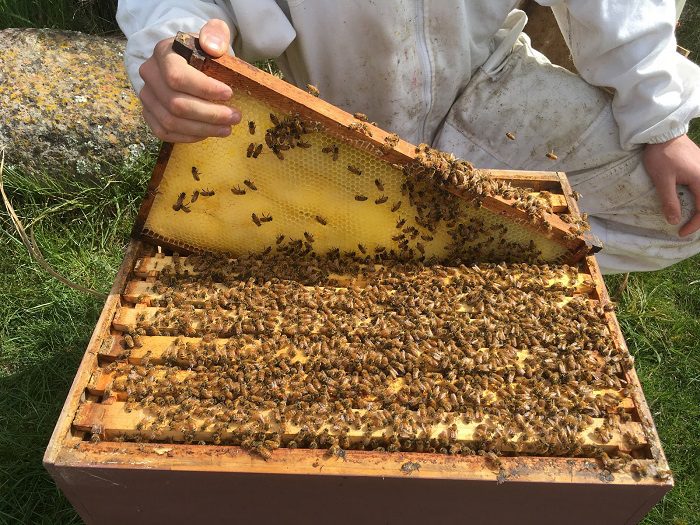COVID ‘Plan Bee’
Mary Hinsen
19 May 2021, 4:05 PM
 It’s World Bee Day today; we take a look at bees in Aotearoa New Zealand and a surprising new role as a tool fighting COVID-19.
It’s World Bee Day today; we take a look at bees in Aotearoa New Zealand and a surprising new role as a tool fighting COVID-19.Scientists have discovered bees may be an unlikely tool for us to combat the coronavirus pandemic.
The United Nations has declared today World Bee Day to highlight the important role bees play both in our health and the health of our environment.
There are almost 20,000 different species of bees in the world.
Dutch scientists announced this month bees may be a possible resource in the fight against the coronavirus pandemic.
A team of researchers at Wageningen University in the Netherlands said they have trained honeybees to stick out their tongues, called proboscises, when presented with the virus’s unique scent, acting as a kind of rapid test.
The scientists hope teaching bees to diagnose the coronavirus could help fill the gap in low-income countries with limited access to more sophisticated technology.
The scientists trained roughly 150 bees with a Pavlovian conditioning method in which they gave the insects a sugar-water solution each time they were exposed to the smell of the coronavirus.
When the bees were presented with a sample that was negative for the virus, they received no reward.
After repeatedly extending their tongues for the sugar water, the scientists said the bees learned to stick out their tongues for a positive sample, even with no reward offered.
Within hours, the insects were trained to identify the virus a few seconds after encountering it.
Research is continuing, and the scientists believe they can achieve about a 95 percent accuracy rate if they use multiple insects to sniff each sample.
The team is also working with a company to develop a biochip using insect genes, which can test rapidly, is non-invasive, cost-effective and highly accurate, and can even recognize the severity of a disease.
Bees are an essential component of our agricultural industries. They support New Zealand’s $6 billion horticulture industry by pollinating food crops, as well as producing a multitude of honey-based products.
Every third spoonful of food you eat depends on pollination by bees.

According to MPI figures, New Zealand had over 918,000 hives in their 2019 count.
Image The Central App archives.
Mary Bumby, the sister of a Methodist missionary, is considered the first person to introduce honey bees to New Zealand. She brought two hives ashore with her when she landed at the Mangungu Mission Station at Hokianga in March 1839.
While New Zealand already had native species of bees, they were not suitable for producing honey - their role was as pollinators.
More bee species were brought to New Zealand in 1843 and in 1848, William Cotton wrote a manual for New Zealand beekeepers, describing the basics of bee husbandry and production of honey.
The New Zealand bush proved a great place for bees, and the number of wild colonies multiplied rapidly, especially in the Bay of Islands.
By the 1860s, bee nests in the bush were plentiful, and considerable quantities of honey were being sold by Māori – the country’s first commercial beekeepers.
Full commercial production of honey in New Zealand began during the late 1870s, following the introduction of the Langstroth hive, the boxed-framed beehive model still used today.
Figures released by the Ministry for Primary Industries (MPI) show our beehive numbers are increasing. According to its apiculture monitoring programme, New Zealand had over 918,000 hives in 2019, in 2005 they had counted less than 300,000.
Beyond the importance of pollination for our farmers, bees help maintain ecological balance and ensure the conservation of biodiversity in nature. At the same time, bees are important bio-indicators of the state of the environment.
Their presence or absence tells us when something is happening with the environment and that appropriate action should be taken to address it.
We have 28 species of native bees in New Zealand. Of those, 27 are endemic – meaning they occur only in NZ, and one is indigenous – meaning it also occurs in Australia but arrived here unaided by humans.
Our native bees are not aggressive and are smaller than honey bees. They don’t have hives or produce honey, they are solitary, living in nests in the ground under bare, undisturbed soils. Each female lays only three to ten eggs before she dies.
They don’t tend to travel far, so need flowers close by to collect pollen to feed their larvae.
Native bees play an especially important role in many of our ecosystems because they are among the most effective pollinators of our native plants, including mānuka and kānuka. And, they are not affected by the varroa mite that threatens honey bees.
To read more about the research into using bees to react to coronavirus, click here
Advertisement



